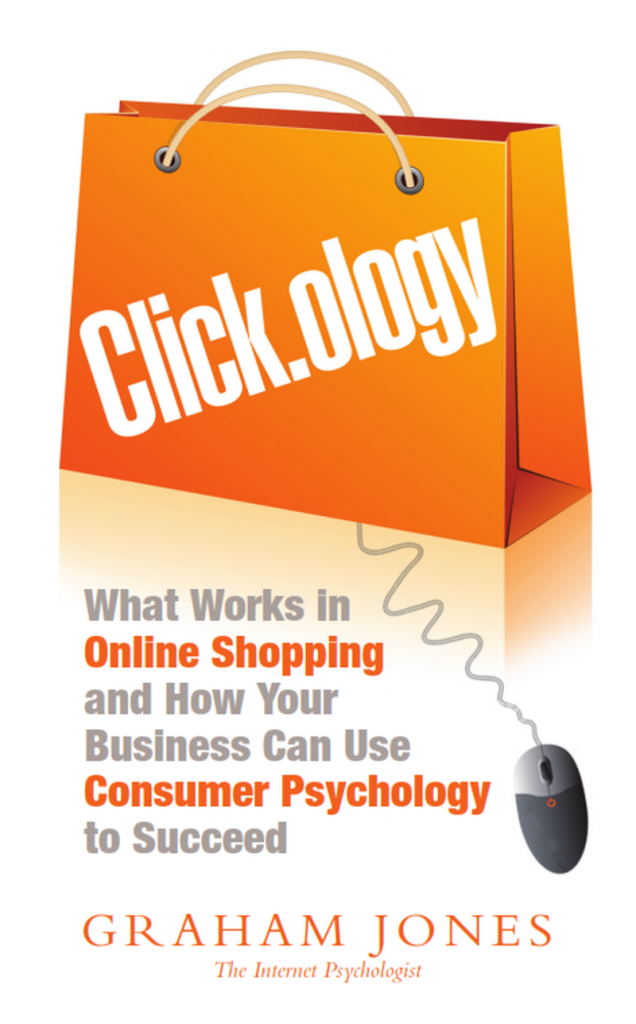
How can you sell effectively online? And what are the key differences between selling online and offline?
To find out, I spoke to Internet psychologist Graham Jones, who has spent the last 15 years analysing how consumer behaviour has adapted to the web.
In his book Click.ology, he argues that companies have yet to adjust to the fact that buyers behave differently in stores and online, and that they must understand why customers buy before designing their websites.
While the book is focused on ecommerce, I was struck by how much of what he said applied to any business promoting a product or service online, including B2B companies.
His insights include:
– Why businesses over-estimate the importance of price online
– The downside of giving away freebies
– How to make the most out of the data you generate online
– How ‘bricks-and-mortars’ stores must adapt if they’re to have a future
And more. Enjoy!
MIRIAM SHAVIV: If businesses aren’t using customer insights to shape their websites, what are they using?
GRAHAM JONES: What they’re using now is guesswork.
The real focus is on the technology. Because the Internet was introduced by engineers, when businesses decide they need a website, it inevitably goes to the tech people. The entire focus is
on getting the website to work and do things speedily, rather than on the users.
There is no real, careful strategic thinking.
It’s beginning to change as big business understand they’ve got technical stuff right, but people are still not buying from them. Companies are realising that what they’re doing is talking to people, not computers.
MS: Why do online retailers understand their customers less than offline retailers?
GJ: Offline, a sales person is trained in upselling and being nice to customers, but a good sales person gets to understand the individual customer before then, using body language and tone. They measure the individual customer in the moment, so they can adapt what they do to each customer. They treat them as individuals.
Then you go online…. The best companies will do six buyer personas, whereas in a real store, there are 100,000 personas. So online they don’t understand the customers as well.
MS: Can’t retailers make up for this with the data they glean online about their users’ behaviour?
GJ: There is a role for ‘Big Data’, but unfortunately it needs big analysis. Companies get trapped in constantly analysing data that gives them useful information, but they can spend months obtaining information they could get by speaking to someone in five minutes.
It shouldn’t be the only thing. You need events and focus groups to gather sub-conscious data to put into their analysis.
MS: What’s the main difference between the way people shop on and offline?
GJ: Generally they’re doing the same thing – looking for a product or service that meets their need at that moment. Online, we’re much more rapid about it. If a website doesn’t have what we want, we’re out of there. In the real world, we wouldn’t even have walked into the shop.
So online retailers need to grab people’s attention much faster. And you can’t just repeat your offline shop online!
MS: In Click.ology, you argue that price should not be a major concern for online retailers. Why is this?
GJ: Companies make this mistake when they focus on the competition rather than on the customer. When you focus on the competition, you worry prices are too high. For customers, it’s not an issue.
A classic example is Tesco. Before it was the UK’s #1 retailer, it was an “also-ran” in the supermarket sector. It was cheap and cheerful, with scruffy little shops, where students shopped.
[Former Tesco head] Terry Leahy tells a story about when he was appointed CEO. He visited as many stores as possible, and in one shop, asked one of his workers whether she liked working in Tesco’s. She said no; she used to work in a corner shop where she knew all the customers, but Tesco is about processing people as quickly as possible.Terry Leahy realised that in all the board meetings, all they cared about was Sainsbury’s – never the customers! He changed the focus to customers, and that was the beginning of Tesco’s journey to become the top UK retailer.
 MS: So how should companies price themselves online?
MS: So how should companies price themselves online?
GJ: Think about the value your product gives customers. Talk to them to understand what it means to them, and how much they will pay for this benefit. It’s possible they’ll value a £10 product at £40….
For example, let’s say you have a product such as a mixer that will help you when preparing food. At the same time, children can use it as well, so you can spend more time in the kitchen with your child, but less time cooking. Wrap it up like that, how much would you pay for that?
Focus on the customer benefit….
MS: Isn’t it easier for customers to compare prices online?
GJ: They do price compare, but only if you’ve focused people’s minds on price. Supermarkets have constant problems because for years, they’ve focused people’s minds on price. Rolex doesn’t tell you the price and people still buy, because they know they’ll get high quality.
MS: Going against conventional wisdom, you are also against giving away freebies online.
GJ: They’re not as vital as people might think. Most people are prepared to go straight to buying.
People don’t appreciate freebies because their experience is that the quality is very low. If the quality is low, it can harm your brand.
Conversion rates to higher-priced products is also very low. Internet marketing gurus tell you to create a free report, use it to build your email list, people will buy and you’ll make millions by tea time. But it’s a treadmill – you have to produce many products because conversion rates are so low.
 MS: You recommend providing as much information as possible about your products online. But don’t people get put off by reams of text?
MS: You recommend providing as much information as possible about your products online. But don’t people get put off by reams of text?
GJ: In a real shop, you get lots of information. You try to reduce the risk of making the wrong purchase by picking up the product, touching it, looking at it from different angles, asking the sales assistant for advice or perhaps a friend if you’re shopping for clothes.
Online, we get given a picture and a short bit of description – it’s not enough to reduce risk.
People like to know there’s information there. Even if they don’t read it all, if it’s not there, there’s no way of reducing risk. It’s about making people feel comfortable.
Amazon has page after page of information. The top products have reviews, videos, product details and specs – as much detail as they can put on it, because they know that products with more detail sell more.
MS: With so much shopping taking place online, does offline retail have a future?
GJ: Definitely. Online is still only 5% of all shopping. We still love real-world shopping because of the ability to touch, but as new technology comes in, we’ll be able to transmit touch online as well.
Shopping offline is still a very social experience. People tend to go shopping with other people, or meet others afterwards to show off what they’ve bought. Offline shops need to take advantage of this.
At the moment, many shoppers use real-world stores as a showroom and buy online. They’d be more likely to stay in the shop if it treated itself as less of a showroom, and more of a destination.
Book shops realised this: You can entice people in by attaching a coffee shop. If more real-world shops could do that, they would beat off the competition.
The problem is that online can be more convenient and quicker, and that’s big competition for the offline world. Shops need to become more fully integrated with the online world. At John Lewis, you have free wi-fi, and the sales assistants have Tablets so you can order online while you’re in the store. You can get your product delivered home or to another John Lewis store – you have the choice you get online.
They’re doing really well drawing the two together, taking people online for convenience while people are in-store.
MS: Graham Jones, thank you very much.






